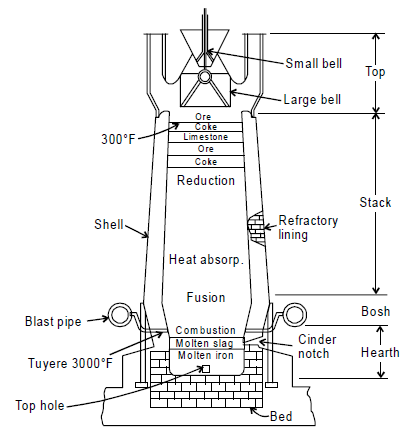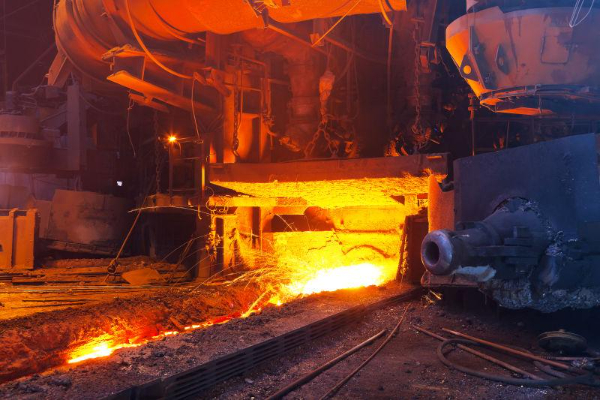Smelting Blast Furnace and Refractories
A blast furnace is a traditional combustion device used to heat metal or other substances. Its basic principle is to provide high-temperature heat energy by providing a large amount of air to the combustion chamber to make the flame burn more vigorously. Blast furnaces are widely used in the rough smelting process of copper, lead, lead-zinc, antimony, and other metals.
The structure of the blast furnace

The blast furnace is composed of a furnace roof, furnace body, main bed (also called throat), hearth, tuyere device, and so on.
Furnace top
The roof is the top part of a blast furnace, also known as the roof. It is a sealed structure used to cover the top of the furnace body to maintain high temperatures in the furnace and effectively control the combustion process. A series of furnace ports or charging ports are usually arranged on the furnace roof for feeding or discharging products into the furnace.
Furnace shell
The furnace shaft is the main cylindrical structure of the blast furnace, which is the container for charge and fuel and houses the smelting process. The furnace body is usually built with refractory bricks or refractory materials to maintain structural stability at high temperatures. There is usually a slag outlet at the bottom of the furnace body to discharge the waste slag generated in the furnace.
Tuyere level or bosh
The bed is the conical lower area of the blast furnace, also known as the hearth. During the smelting process, ore, coke, and other fuels are put into the bed through the furnace roof. In this bed, the smelting reactions start to take place and the resulting hot gases and liquid metal rise to the upper area of the furnace shaft.
Blast furnace hearth
The hearth is another common name for the bed, which is the area directly related to the smelting reaction in the blast furnace. In the hearth, the high-temperature gas produced by coke combustion reacts with the iron ore, reducing the iron ore to liquid iron, while the waste slag forms scum and floats on the surface of the molten iron.
Tuyere System
The tuyere device is an important part of the blast furnace. It is used to introduce high-pressure air (usually furnace air) into the bottom of the furnace to control and maintain the oxygen supply required for the smelting reaction in this bed. There are usually multiple tuyeres distributed around the perimeter of the blast furnace, which is connected to high-pressure fans and ductwork. By adjusting the position of the tuyere and the airflow, the operator can precisely control the temperature and reaction process in the furnace.

How a blast furnace works?
Solid materials such as smelting charge (concentrate, sintered ore, ва ғайра.), coke, flux, and reverse material are added from the top of the furnace, and the high-pressure air blown into the tuyere device on the side of the lower part of the furnace body is in the process of going up, and the downward Materials undergo reactions such as melting, oxidation, and reduction to complete the smelting process. Liquid metal, matte, and slag are discharged from the throat or hearth at the lower part of the furnace, and flue gas, smoke dust, gaseous metals, or metal oxides are discharged from the flue gas outlet on the furnace top.
Which refractory materials are used in blast furnaces?
At present, most of them are closed furnace roofs, and the furnace body is a full water jacket. Refractory materials are only used in the throat and heart, because the slag is alkaline slag, so the throat part is mainly made of magnesia bricks, magnesia-chrome bricks, and aluminum-chrome bricks; The upper part is made of magnesia bricks, magnesia chrome bricks, and aluminum chrome bricks; the bottom of the furnace is built into a reverse arch
 Заводи рефрактори Ронгшен
Заводи рефрактори Ронгшен
WeChat
Коди QR-ро бо wechat скан кунед